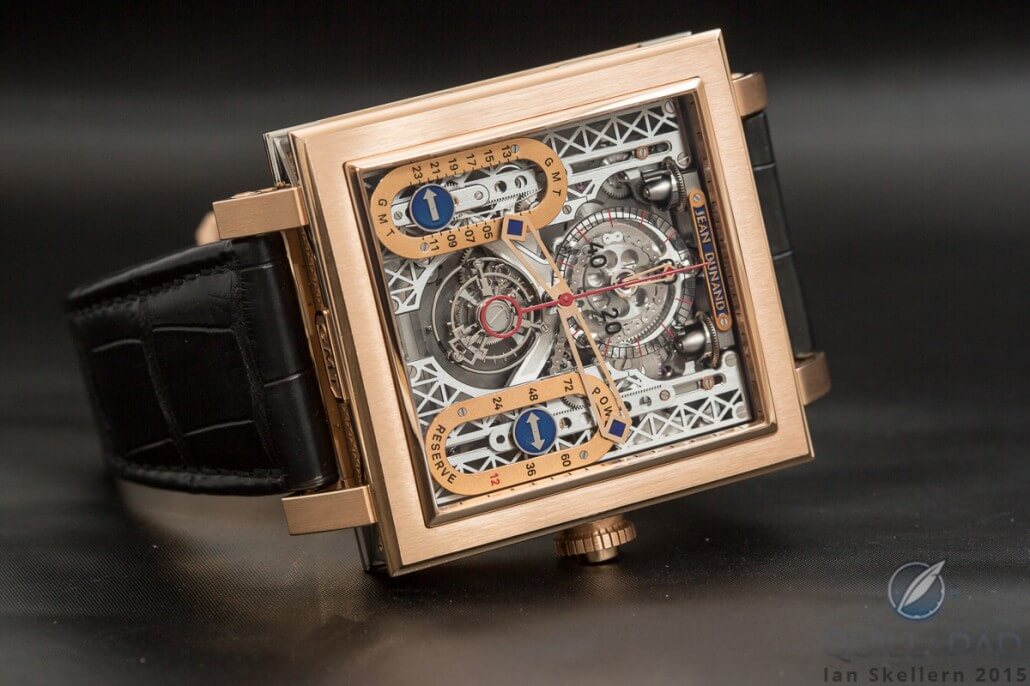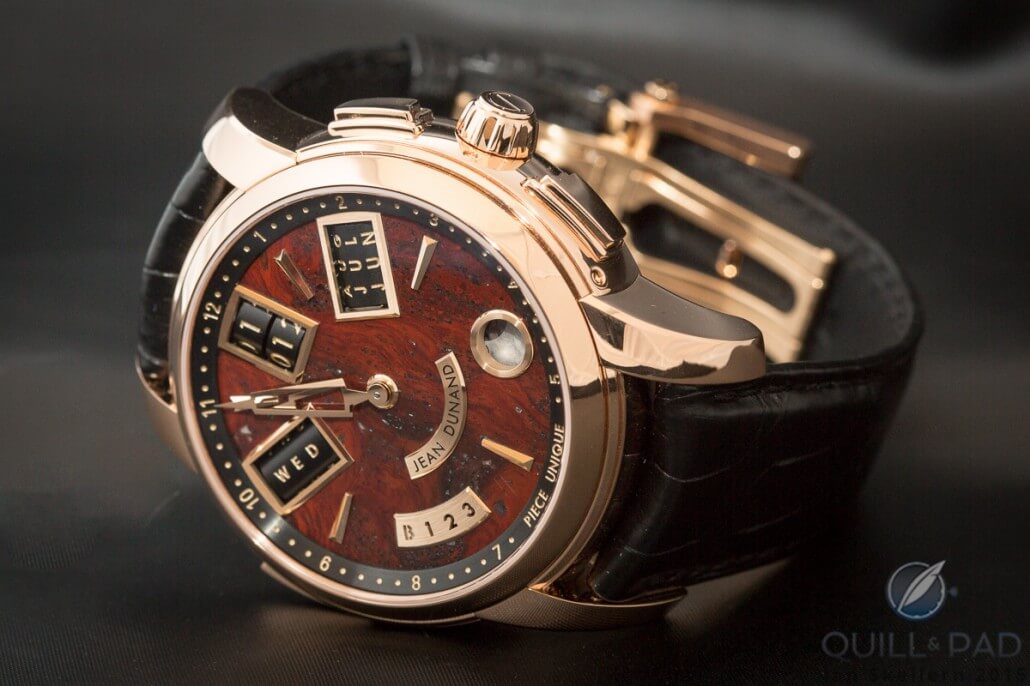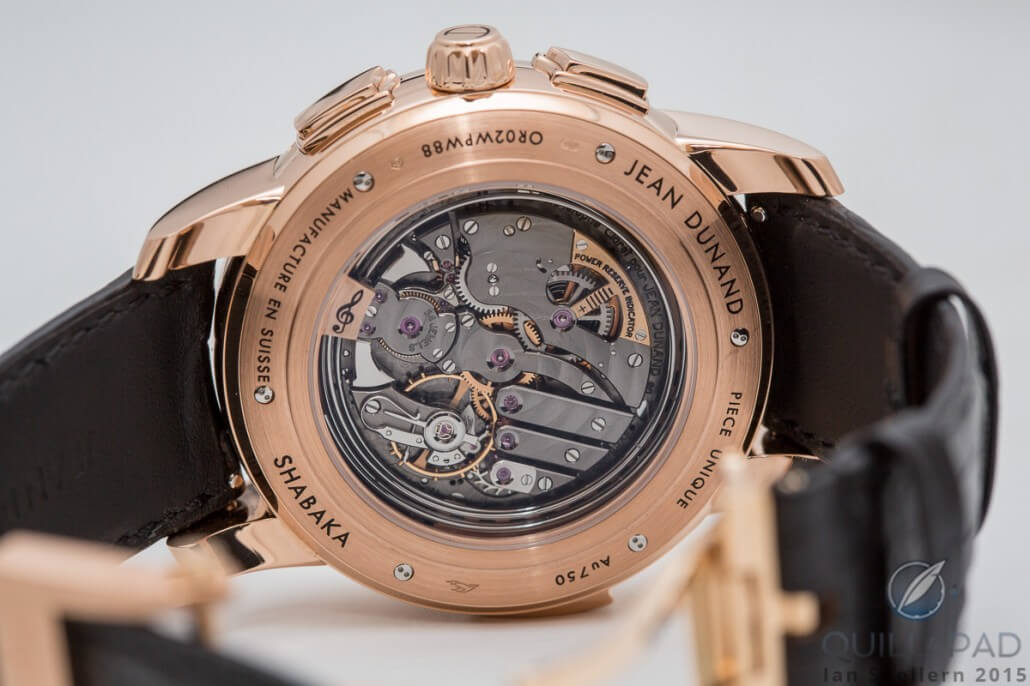It had gone a little quiet around Jean Dunand since the untimely passing of co-founder Thierry Oulevay in 2013.
Oulevay was an interesting and cultured person. I very much enjoyed discussing with him the industry and various aspects of the art form we were both passionate about. Which is one of the reasons I am particularly happy that his co-founding business partner in Jean Dunand, Christophe Claret, has decided to reinvent the Shabaka and bring it back into the public eye.
When the pair launched Jean Dunand back in 2003, it had an alluring, artistic aspect to it. The Tourbillon Orbital, the boutique brand’s premier timepiece, making its debut in 2004, was conceived to be outfitted with unique dials for each client. A sort of bespoke system that in 2004 was a relatively novel concept. The dials were generally created in some rare artisanal art form or semi-precious stone.
The Shabaka, first introduced in 2007 and named for a twenty-fifth dynasty pharaoh of Egypt, was different from Jean Dunand’s other timepieces. The Art Deco-inspired watch could be customized, but its shaped case and unusual displays comprising cylinder rolls was not easily combined with stones and the type of dials that were common on the Tourbillon Orbital.
The new Shabaka is thus presented for the first time in a round 47 mm case – perfect for combining with artisanal dials.
Shabaka’s perpetual calendar
Instead of using conventional disks, Shabaka’s instantaneous perpetual calendar comprising displays of the day, date, and month on four rotating cylinders made of anti-corondal (an aluminum material for lightness) are rotated by four individual transmission systems set at 90 degrees, each fitted with a security device to guarantee precise and instant calendar change.
The calendar indications jump forward immediately at midnight, which is the time when a spring mechanism releases, rather than creep ahead over a period of several hours like conventional disk displays. This instant-change system is one that Claret patented while making this movement, which could also be described as a pre-winding system that saves up energy to make the daily jump.
The system permanently winds the spring and boasts twelve hours of constant reserve, which also compensates for the loss of amplitude that the jump creates. Thus, the rate remains stable despite the changes in amplitude.
The leap year indication is located on the bottom left-hand display. The number that is visible to indicate the current state of the four-year cycle is depicted by a white plate underneath the dial, shining through to illuminate the correct year. The three non-leap years are denoted by 1, 2, and 3, while the leap year is portrayed by the letter B, standing for the word bissextile (the French word for “leap year”).
The corresponding moon phase display is positioned opposite the leap year. This indication is especially clever: black disks travel the surface of the moon, actually eclipsing it like the earth might really do. The moon is eclipsed from the left as it wanes, and revealed from the right as it waxes. This mechanical moon and its clever eclipses deviate by only one day in 120 years.
Though the buttons on the side of the 47 mm case may make it look like a chronograph, they are in actuality there for the calendar functions, thankfully taking the place of recessed correctors. The button at 4 o’clock advances all of the calendar functions simultaneously by one day. The button at 2 o’clock advances the day only. There is also a pushpiece in the crown to set the months and years separately, while a pushpiece in the case band at 5 o’clock sets the moon.
Shabaka’s repeater
The best Claret timepieces include chiming functions – you could call it his signature complication.
Naturally the Shabaka is outfitted with a minute repeater on two cathedral gongs that loop all the way around the perimeter of the movement twice so as to give them a deeper, more resonant chime.
Integrating these particular gongs into the movement was relatively difficult – they also dictate the size of the case – because of the perpetual calendar’s display rolls, which take up a lot of room in the movement. The repeater chimes the hour, quarter hour, and minutes on the two gongs and is activated by the slide on the left side of the case.
Manually wound Caliber CLA88QP is a 13-ligne (29.5 mm) repeating movement perched upon a 14-ligne (36 mm) calendar plate; the total height, including all indications that jut out of the dial, is 12.19 mm. The 7 mm-diameter cylinders for the calendar displays go 2.5 mm down into the minute repeater level of the movement to reduce height as much as possible. The circular-grained base plate and bridges decorated with concentric côtes de Genève are finished in an anthracite color that contrasts beautifully with the burnished steel parts and ruby jewel bearings – all of which are visible through the sapphire crystal case back.
Also in clear view on the back is the ingeniously simple power reserve indication, which makes for a nice contrast to the complexity of this grandiose movement. Basically, this indicator is a scale that has been added over an open spring barrel. It doesn’t get much more original than this: the state of the mainspring located inside this barrel basically shows itself in relation to the added scale indication. Therefore, not one moving part was added to the movement to create it. The Shabaka possesses 45 hours of power reserve and beats at 18,000 vph. The latter fact is interesting because the original Shabaka was set at a slightly higher frequency of 21,600 vph.
Shabaka’s dial
Next to the case shape, this is the point where the Shabaka has changed the most.
Previously, the shaped case played host to an incredibly complex geometrical dial that was chiefly characterized by the original cylindrical calendar displays and composed of four levels on a nickel alloy frame, with the black fields (made of blackened gold) framing three-dimensional pyramids crafted in rose gold.
The new dial, as previously stated, follows more along the lines of the Tourbillon Orbital concept, with each one a unique piece of art created in dialogue with its future owner.
For more information, please visit www.jeandunand.com.
Quick Facts
Case: 47 x 17.65 mm; white gold, pink gold, palladium
Movement: manually wound Caliber CLA88QP; 721 components; two cathedral gongs wrapped twice around the movement
Dial: each dial is a unique and bespoke métier d’art creation
Functions: hours, minutes; power reserve indication; instantaneous perpetual calendar with day, date, month, moon phase, leap year cycle; minute repeater with hours, quarters, and minutes on two cathedral gongs
Limitation: each piece is unique thanks to bespoke dial
Price: around 465,000 Swiss francs depending on customization










Trackbacks & Pingbacks
[…] IS: I was also very happy to see Jean Dunand back at it and am looking forward to what this boutique brand might bring out in future. (For a look at what came out at Baselworld, please read Jean Dunand’s Shabaka Returns.) […]
Leave a Reply
Want to join the discussion?Feel free to contribute!